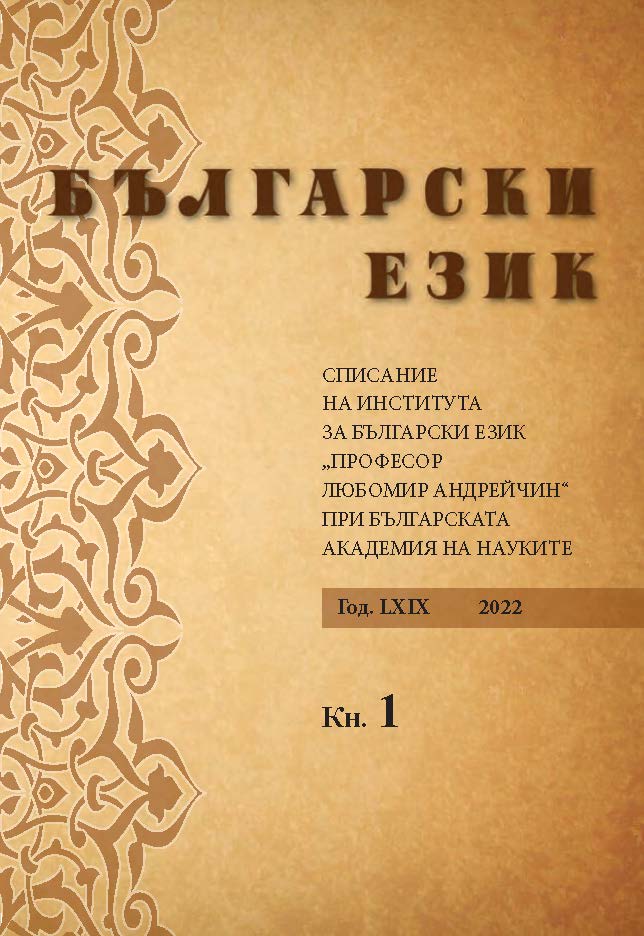СИНТАКТИЧНА ХАРАКТЕРИСТИКА НА ПРОСТИ ГРУПИ С ГЛАВЕН ЧЛЕН ГЛАГОЛ И ПОДЧИНЕН ЧЛЕН НАРЕЧИЕ (V → ADV)
SYNTACTIC CHARACTERISTICS OF SIMPLE GROUPS CONSISTING OF A HEAD VERB AND A SUBORDINATE ADVERB (V → ADV)
Author(s): Katya CharalozovaSubject(s): Language studies, Language and Literature Studies, Theoretical Linguistics, Applied Linguistics, Philology
Published by: Институт за български език „Проф. Любомир Андрейчин“, Българска академия на науките
Keywords: simple syntactic constructions; verbs; adverbs; connotation; accommodation; syntax; Bulgarian language
Summary/Abstract: The article aims at providing a precise formal description of the syntax of simple constructions consisting of a head verb and a subordinate adverb. The analysis employs the mechanisms of syntactic accommodation and connotation. The study of the processes of accommodation and connotation in simple syntactic constructions of the type V → Adv in terms of the presence or absence of connotation (+/- connotation) has resulted in distinguishing two subtypes of syntactic constructions: 1. Non-connoted simple syntactic groups consisting of a verb and an adverb; 2. Con-noted simple syntactic groups consisting of a verb and an adverb. Within the first type of constructions two subtypes have been further identified on the basis of the presence or absence of the feature of accommodation (+/- accommodation) – constructions in which the adverb is not connoted and not accommodated and constructions that are not connoted but are accommodated with respect to the categories of person, number, aspect, tense, mood and polarity. Within the second type of constructions the presence or absence of the feature of accommodation (+/- accommodation) has also led to distinguishing two subtypes: a group of syntactic constructions without accommodation according to person, number, aspect, tense, mood and polarity, and a restricted group of syntactic constructions that are accommodated according to the categories of polarity, person and number. The analysis employing the chosen methodology extends and refines previous descriptions of the simple syntactic constructions with a head verb and a subordinate adverb. The article aims at providing a precise formal description of the syntax of simple constructions consisting of a head verb and a subordinate adverb. The analysis employs the mechanisms of syntactic accommodation and connotation. The study of the processes of accommodation and connotation in simple syntactic constructions of the type V → Adv in terms of the presence or absence of connotation (+/- connotation) has resulted in distinguishing two subtypes of syntactic constructions: 1. Non-connoted simple syntactic groups consisting of a verb and an adverb; 2. Con-noted simple syntactic groups consisting of a verb and an adverb. Within the first type of constructions two subtypes have been further identified on the basis of the presence or absence of the feature of accommodation (+/- accommodation) – constructions in which the adverb is not connoted and not accommodated and constructions that are not connoted but are accommodated with respect to the categories of person, number, aspect, tense, mood and polarity. Within the second type of constructions the presence or absence of the feature of accommodation (+/- accommodation) has also led to distinguishing two subtypes: a group of syntactic constructions without accommodation according to person, number, aspect, tense, mood and polarity, and a restricted group of syntactic constructions that are accommodated according to the categories of polarity, person and number. The analysis employing the chosen methodology extends and refines previous descriptions of the simple syntactic constructions with a head verb and a subordinate adverb.
Journal: Български език
- Issue Year: 69/2022
- Issue No: 1
- Page Range: 88-102
- Page Count: 15
- Language: Bulgarian

